|
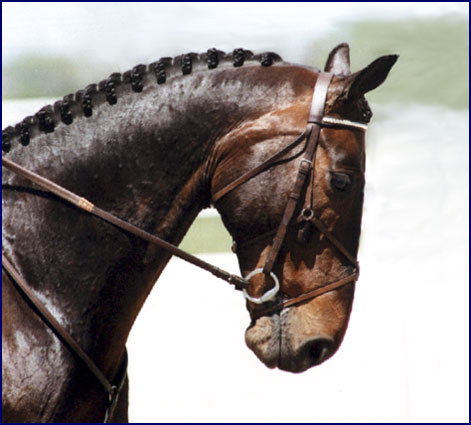
OLYMPIC MEMORIES
By
Phyllis Dawson
The
24th Olympic Games, Seoul, Korea, 1988


Competing
in the Olympics is the experience of a lifetime.
I was lucky enough to get the opportunity to ride in the 24th
Olympic Games, in Seoul, Korea, in 1988.
I bought Albany II, my Olympic mount, in
England in 1985. I was looking
for a young horse with International level potential, and Bruce Davidson
helped me find him. I quickly
came to appreciate Albany's wonderful personality; he was an affectionate
and trusting horse who always tried his best one hundred percent at
everything he did. We formed a
special bond. Of course, I had
dreamed of representing the United States in international competition all
my life - but until Albany came into my life I never really believed I
would get there.
In the spring of 1988, we competed in the
final Olympic selection trial at the Rolex Kentucky Three Day Event, over
one of the biggest cross-country courses I had ever seen.
I remember walking the course that year and being absolutely
awestruck by the difficulty of the fences.
Albany and I had placed 2nd at the Chesterland CCI the
autumn before, but this Lexington course was far more demanding.
“Like Badminton, but without the options,” people were saying.
|
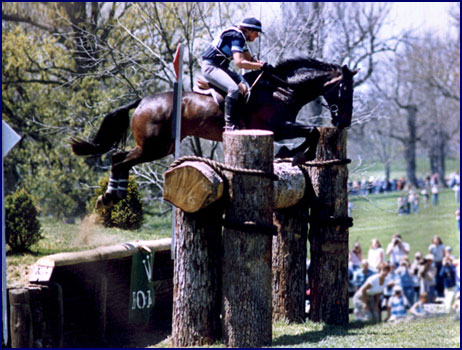

Albany on course at the final selection trials in 1988 at
Rolex Kentucky.
|
Bruce Davidson was my
coach, and he was riding four horses.
He had a bad fall on his first horse and broke several ribs, and
rode the other three horses in extreme pain.
I re
member seeing him in the vet box after his second horse, and unaware of
his injuries I asked him how the course was riding.
He answered, “Everything is riding much worse than we thought,”
and then walked away. But
despite this less than confidence-inspiring send-off, I managed to jump
clear around the course, placing 5th and earning a spot on the
Olympic Team.
The horses
were in quarantine in Unionville, PA for a month before shipping out to
Seoul. I had dreamed what it
would be like to be selected for an Olympic Team, but the reality was far
more stressful than I could ever have imagined.
The weather was horribly hot, the ground was hard as a brick, and
we just hoped and prayed the horses would stay sound and healthy as we did
our preparation work.
|

Galloping on Nelsons's Hill in Unionville with Bruce,
preparing for the Olympics.
(Yes, we rode without hats in
those days. Would not do so now!)
|
It is a weird and
difficult situation to be in. On
the one hand you are living the dream, with fundraiser parties and media
interviews, and everyone treating you like a celebrity.
But on the other hand you are under all this pressure, afraid to
jog your horse each day for fear he will be lame and you won’t be able
to go, and worried that you might let your team and your country down if
you do go. It is enough to
make you a little crazy! The
horses felt the pressure too. When
the van finally came to take the horses to the airport, Albany dragged
Jineen, who was grooming for me, up the ramp.
“Let’s just get on with it already!” he seemed to say.
We shipped to Seoul over two weeks before
the games in order to give the
horses a chance to recover from the trip and acclimate.
I flew with the other riders; my teammates were Bruce Davidson,
Karen Lende (O’Connor), Ann Sutton (Taylor), and Jane Sleeper. Michael
Paige was our chef d’equipe.
We went by way of Los Angeles, where we
were fitted out with our Olympic kit.
We were given suitcases full of clothes; literally we could have
taken nothing with us except underwear and been fine.
From there we had a seventeen hour flight to Tokyo, and then on to
Seoul. I sat with Bruce
Davidson and equine therapist Dougie Hannum, and the three of us
celebrated the trip with more champagne than was good for us.
Jineen got to fly with the horses, by way of Alaska where they
landed for refueling.
Upon arrival in Seoul, we were
‘processed,’ which involved a lot of waiting around while our
credentials were sorted out. It
seemed like for every job involved with the Olympics, there was a whole
group of Koreans standing around waiting to do each task.
We called these groups the ‘Korean Committees.’
Despite all the extraneous personnel, things moved very slowly.
We were to learn that the Korean people
were unfailingly polite. They
considered it rude to answer ‘no’ to a question, so instead they
always said ‘yes.’ But
where we would take this to mean, ‘Yes, I will do what you ask,’ what
they really meant was ‘Yes I understand the question and will consider
your request.’ This led to
several misunderstandings.
|
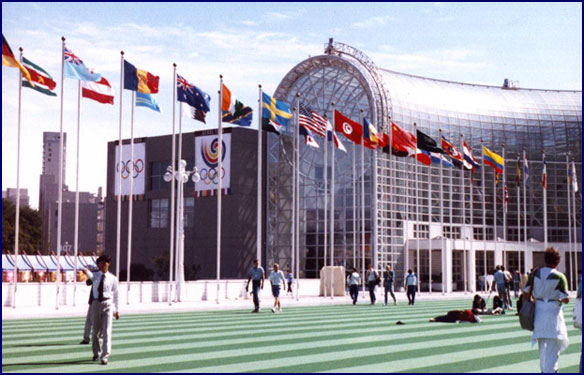
The glass cafeteria and flag courtyard in the Olympic
Village.
|
The Olympic Village was
incredible. It was a community
of high-rise apartment buildings that had been built to house the
thousands of athletes participating. The
cafeteria was a tall building made of glass.
Central in the Village was a big open square, covered in green
astro-turf, and surrounded by 159 flagpoles, for the 159 nations
competing. When each
country’s full delegation of athletes arrived their flag would be run
up. At first just a few flags
were displayed, but as it got closer to the games more and more went up
each day, until finally the square was lined with the bright colors of the
flags from every nation competing.
One of my abiding memories is the sound of
many voices chanting in the pre-dawn hours each morning in the Olympic
Village, which I think were people of eastern religions worshiping as they
greeted the day.
Jineen stayed at the
equestrian venue, which was at the Seoul racecourse.
It felt strange for us to be separated like this, because normally
when Jineen would groom for me at the big competitions we did everything
together. It was hard for me
to not have access to my horse whenever I wanted; the riders would be
driven to the stables every morning to ride, but we all had to return to
the Olympic Village at the same time.
I knew Jineen and the others were taking great care of the horses,
but I was used to being there myself.
We had a shuttle bus that took us to and
from the racecourse. We were
always eager to get to the stables, so we would pile into the van and say
to the driver, who never seemed to be in a hurry, “Let’s go!” But
finally toward the end of our stay we had managed to convey some sense of
urgency to him; when we piled into the van one day he turned to us and
grinned, and uttered what was apparently the only two English words he
knew. “Let’s go!”
|
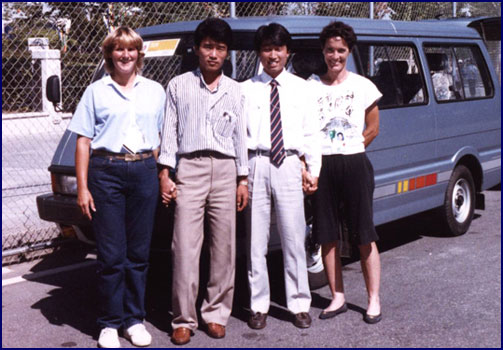
Jane Sleeper and I pose with our shuttle bus
drivers.
|
Traffic in and around
Seoul was crazy, and our driver had no qualms about cutting across six
lanes of traffic to make a turn. Security
at all of the venues was intense; when we pulled into the stable area
security men would slide mirrors under the van to check for bombs.
We went through metal detectors and had our bags searched every
time we entered the Olympic Village or any of the venues.
The entire
equestrian venue was surrounded by a huge chain link fence, probably 14
feet tall, with coils of barbed wire on the top.
Just inside the fence we were surprised to see little stacks of
rocks every few feet, with a vertical strip of white carefully painted on
the side of the stack. This
was so that if anyone came over the fence the rock stacks would be
disturbed, and the intruder’s presence would be detected.
Every couple hundred yards was a guard tower, manned with soldiers
with machine guns.
The horses lived in comfortable concrete
block stables. The main arena
was on the racecourse, in front of the grandstands.
There were several dressage schooling areas, and we could gallop on
the racetrack, though the footing was not good.
The only hacking was a little trail that went around the compound
just inside the fence. After
being there several weeks, the horses were feeling a bit constricted; they
are used to open spaces and hacking out.
It was a tense time; so many things can go wrong at this level, and
I was terrified that something would happen to prevent me from competing.
|
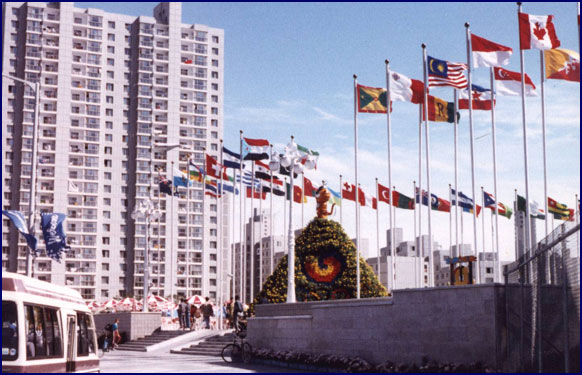
Banks of flowers topped by the Olympic mascot
Hodori, at the entrance to the Olympic Village.
|
Everywhere we looked,
the city was decorated with Olympic symbols and Korean swirls, often
created with huge banks of multi-colored flowers.
The Olympic mascot was a tiger named Hodori; his image was
everywhere.
We tried to savor the experience of living
in the Olympic Village. It was
amazing to mix with the athletes from all over the world.
We ate our meals in the huge glass cafeteria, which was really
interesting. The food was
pretty good, with selections from all over the world.
There were always huge pots of kimchee, made from fermented
cabbage, a staple of the Korean diet.
The pungent smell of the kimchee permeated the cafeteria, and after
a while it seemed the whole village smelled of it.
I often went to the cafeteria with Jane
Sleeper, and at each meal she insisted that we sit down and talk with
someone from another country and another sport. We
would watch the people in the food lines and try to determine what their
sport was by the shape of their bodies.
We would compare the muscular boxers and wrestlers, the huge weight
lifters, and the tiny gymnasts. The
swimmers had distinctive physiques, and the marathon runners were tall and
lean, appearing somewhat emaciated.
On one occasion we were finishing our meal
when four or five huge black men in long flowing African robes sat down
around us. They were heavily
muscled, and their faces were somewhat bruised and marked up.
We thought, these guys have to be either wrestlers or boxers –
but it turned out that they were the Nigerian Ping Pong team!
|
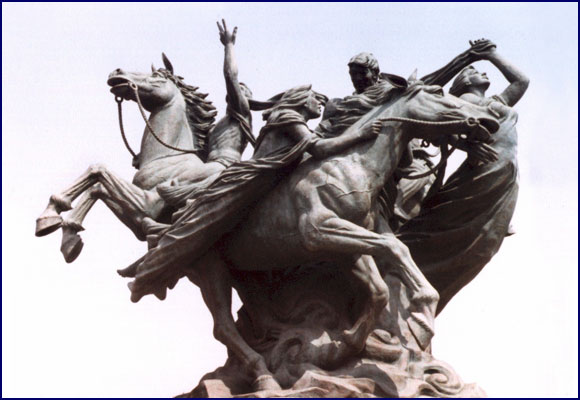
The Amazing statue near the entrance to the
Seoul Racecourse.
|
Near the Equestrian
venue entrance, there was an amazing statue.
Set in a circle were three larger-than-life horses, plunging and
leaping, ridden by what appeared to be divine beings come briefly down
from heaven. It was probably
the most beautiful piece of art I have ever seen.
Jineen was having fun at the equestrian
venue as well. The food there
was not as good as ours in the Village, but grooms do know how to party.
The Eventing grooms from various nations got together and staged a
Chariot Race, in which Jineen was a participant.
Unbeknownst to me, she borrowed my cross-country body protector and
glued paper wings on my riding helmet.
So attired, she rode in a wheelbarrow, pushed by Ann’s groom,
Maureen. I believe they
capsized.
|
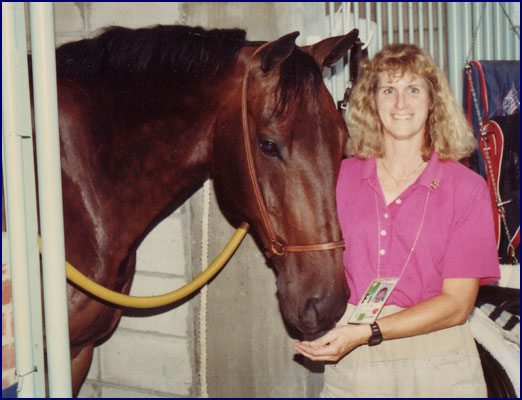
Jineen and Albs in the stable.
|
My
mother was there in Seoul too. The
Seagram’s company had sponsored family members of all the athletes to
come to the Olympics, paying their airfare and putting them up in the
‘family village.’ It was
great to have Mom there to share in the experience.
The Korean people seemed to be fascinated by her white hair, and
always wanted to touch it.
We went shopping several times in downtown
Seoul. We went to an area that
had dozens of little booths on the street, selling everything from
clothing to jewelry to eel-skin purses.
We got some amazing deals on custom made silk shirts and coats.
Tommy Wilson (riding for Puerto Rica) bought a Rolex watch, but it
was a fake and the hands fell off it by the time he got back to the
stables. Pin trading is also
an Olympic tradition. The USOC
had supplied us with a collection of US pins, which we traded with
athletes from other nations.
I was not very daring about trying the
local cuisine. I did not enjoy
the smell of kimchee, and the masses of squirming live eels sold at the
marketplace made me feel rather sick.
We had heard a lot about the fact that Koreans eat dogs and cats,
but restaurants in Seoul were actually banned from serving those dishes
during the month of the Olympics, so as not to offend western visitors.
Nonetheless, we noticed that we saw many puppies around the streets
of Seoul, but very few adult dogs.
The Korean language was quite difficult;
it sounded like total gibberish to us.
Even after spending nearly a month there, the only Korean word I
was able to learn was gam se uam ni da, which I think means thank you.
Riding just one horse a
day, it was important to find ways to keep fit.
There was a gym in the Olympic Village, and areas for jogging.
I had slightly sprained my ankle before the trip, so I had to be
careful about running on it. I
found I could run up staircases without pain, but it was uncomfortable to
walk down the steps. So I
would run up the dozen or so flights of stairs to the top floor of our
apartment building, ride the elevator back down, and then run up again.
As we got closer to the start of the
games, the atmosphere at the stables was filled with excitement.
The Olympic theme song for the Games, Hand in Hand, was quite
inspiring, and they played it over the sound system often, in both English
and Korean.
Because of the heat in summer in South
Korea the Games were held in late September, but it was still quite hot,
so we worked the horses early in the morning.
I would take Albany out for a handgraze in the afternoons.
There were always quite a few Korean men around the grounds, and
often they wanted to come and see Albany, and have their picture taken
with him. Albs was usually
quite friendly, but he was quite suspicious of the Koreans when they
approached; I think it may have been because they smelled like kimchee.
Jineen had collected dozens of four-leaf
clovers at home before we left, and had pressed them and put them in a
gold picture frame for me as a gift. I
hung that on Albany’s stall to bring us good luck.
|
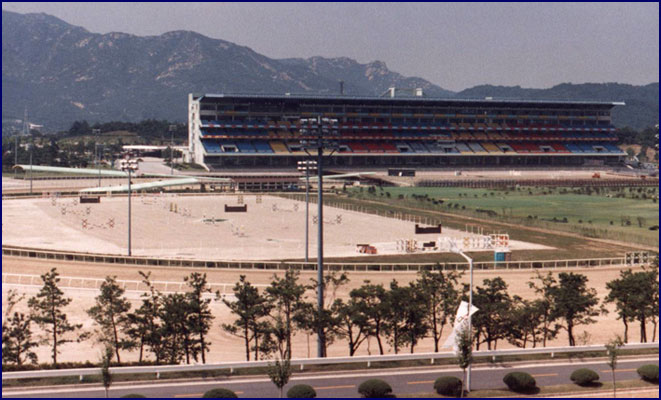
The Seoul Racecourse, which was the Equestrian
Venue for the 1988 Olympics.
|
Finally it was time for
the Games to begin. Eventing
is always at the very beginning of the schedule, and we had our first
veterinary inspection in the morning on September 17th, the day
of the Opening Ceremonies. It
was a great relief to have the jog-up over with.
The team consisted of Bruce Davidson with Dr. Peaches, Karen Lende
(O’Connor) and The Optimist, Ann Sutton (Taylor) with Tarzan, myself
with Albany II, and Jane Sleeper as the alternate rider.
The Opening Ceremonies are always really
interesting to watch on television, but it is very different from the
athlete’s perspective. We
spent most of the ceremony lined up on the hot tarmac outside the stadium,
waiting for our time to enter. Toward
the end of the ceremonies, each nation’s athletes would enter the
stadium and walk around the track, in alphabetical order by country. We
were instructed to form rows for the procession around the track, but
there were hundreds of athletes and coaches there from the United States,
and unfortunately nobody to take charge and direct us.
So while most of the other countries’ athletes marched in orderly
columns, the Americans ended up entering the stadium in a slightly
disorganized group, looking around in awe and waving at the crowds,
savoring the moment. We were
later criticized in the press as appearing disrespectful, but actually we
just needed a drill sergeant.
But despite the glitches in our
organization, there is no feeling in the world like walking into that
Olympic Stadium in front of 100,000 people. The
Olympic torch was lit and the Olympic flag was raised.
It was an extraordinary experience, and an incredible sense
of patriotism welled up inside us.
Finally the start of the
competition came. It had been
decided that I would go first for our team, so I had an early ride time.
I worked Albany in the morning, and then returned to the stable for
Jineen to braid him before the test. When
I got back to the stall slightly later than planned, Jineen told me that I
would have to braid Albs myself, since I was the faster braider and I
hadn’t left her enough time. The
other riders seemed surprised, but Jineen was my best friend as well as my
groom, and it worked out well since it gave me something to focus on
besides my nerves.
I was nervous of course, but I was also
having the time of my life. After
all, this is what I had spent years working for, and now I was going to
enjoy every last moment of it. Albs
was also enjoying himself; he had definitely picked up on the atmosphere -
he liked crowds, and was enough of a showman that he was quite pleased
that everyone was looking at him.
Albany warmed up well, but when we entered
the final holding area before our test he got a bit tense, no doubt
responding to my own tension. There
was a lot of atmosphere, with flowers and Olympic logos and the huge
grandstands. But as soon as we
started trotting around the outside of the arena, he began to buckle down
to business.
I will never forget the feeling of riding
around the outside of the dressage arena just before beginning my test,
and looking up at the big scoreboard and seeing my name in lights:
Phyllis Dawson, Albany II, USA.
As I turned up the center line, I was thinking, "Oh my God,
this is it! I am actually
riding in the Olympics!" It
was the culmination of many dreams. It
was a pretty emotional moment, and it made me feel so proud to be there,
riding in the Olympics, representing my country.
I rode into that arena feeling on top of the world, and Albany put
in the best test of his career. We
finished the dressage phase in 10th place.
|
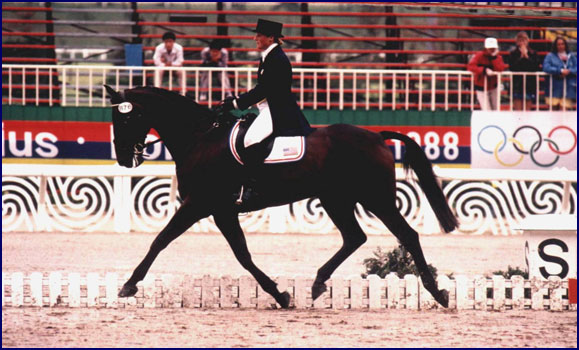
Phyllis Dawson and Albany II, USA.
|
Since
we went early, when our marks were announced we had the best score so far,
and for a brief time were in the lead.
My mother started telling everybody she saw, “My daughter is
winning the Olympics!” Embarrassed,
I tried to shush her, pointing out that none of the really top horses and
riders had gone yet. “I
know,” she answered, “that’s why I am saying it now, while I can!”
I was drug tested immediately after my
test. Jineen took Albany back
to the stables, and I was taken into the testing area to produce a urine
sample. This can be harder
than you think, because before competing you have to go about a hundred
times from nerves, then you get a little dehydrated competing in the warm
weather. And of course it
doesn’t help that you have a stranger standing in the little bathroom
with you, watching to make sure you don’t switch samples!
When I finally finished and returned to the stables, I didn’t
have my photo ID; I had taken it off to compete, but now separated from my
horse I couldn’t get in.
Our team had driven an
hour north of the city, to Wondang Ranch where the cross-country was held,
to walk the course. It was in
the DMZ, the de-militarized zone, right by the North Korean border.
If we had thought the security was strict in Seoul, it was even
crazier here. We were told
that under no circumstances were we to wander about off the track of the
course or at odd hours, at risk of being shot!
We walked the cross-country five times,
learning every twist and turn on the course.
On one occasion there were several military men with guard dogs at
the water jump; I made the silly mistake of trying to pet one of the dogs
and got bitten for my effort. The
guards were appalled and dragged the dog away; I hoped that it did not end
up as somebody’s dinner.
The course was lovely.
Like many Olympic courses it was twisty and hilly, with roped
galloping lanes that wound around the venue.
The entire track of the course was lined with cosmos, blooming in
purple, pink and white, which had been planted along the sides of the
galloping lanes. To this day,
whenever I see cosmos blooming I think of the cross-country course in
Seoul.
It was a very demanding course, and the
general consensus among the participating countries was that it was
unusually difficult for an Olympic Games.
Generally the Olympic courses were designed so that the best horses
and riders would need to take the faster, more difficult options to win,
but the slower routes would be easy enough to allow the less experienced
nations to get their riders home and finish as a Team – however this did
not seem to be the case in Seoul. It
was clear that we had our work cut out for us.
The jumps were big, needing a bold
horse, and there were quite a few accuracy questions as well.
In those days the courses were much less technical than now, but
very big and very upright. Often
the fences were built of flimsy materials; for instance the first water
jump was a combination of absolutely vertical fences into the water,
almost four feet high, constructed of three rails that were basically
two-by-fours, with no fillers.
What I remember most was the distance.
For Phases A and C combined, the Roads and Tracks, we had to do a
brisk trot at 240 meters per minute for an hour and a half.
The Steeplechase was four and a half minutes on a figure-eight sand
track, and Phase D, the actual cross-country, was over 13 minutes.
It was a huge test of endurance for the horses.
The Roads and Tracks went down little sand
lanes and past rural villages. There
were obvious security procedures everywhere, such as guards with machine
guns standing in the rice paddies with their backs toward us, watching the
woods beyond. Korean children
played in the roads. We saw
women doing their laundry by beating it with a rock by the well, or laying
chili peppers out to dry, or sifting grain through a cloth.
Almost everyone we passed smiled and waved enthusiastically.
Living in the Olympic Village we were somewhat isolated from the
real world, but here we felt like we were really experiencing Korea.
But the route was very confusing, and I was terrified that if some
of the directional markers got taken down I would get lost.
We shipped the horses up to the stables at
Wondang Ranch after dressage. We
spent the nights before and after cross-country in a college dormitory
nearby. There were shuttle
buses to drive us to the stables in the morning; we were cautioned not to
try and walk the half mile to the stables under any circumstances, as we
would be mistaken for intruders by the guards and shot.
|
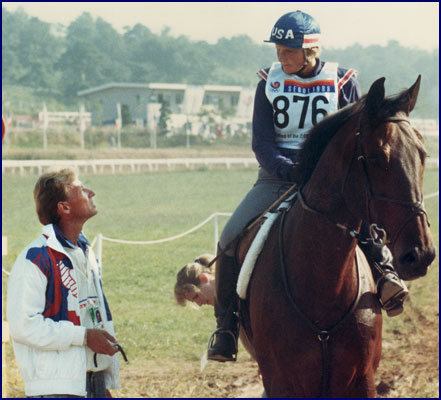
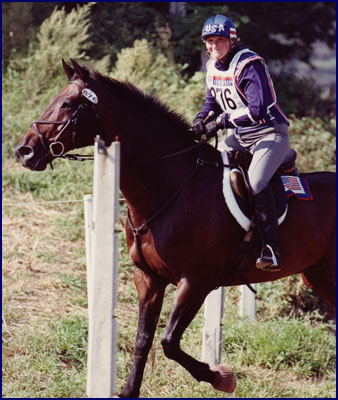
Bruce gives me advice before Steeplechase, and
trotting on, Roads and Tracks.
|
Tension was high on
cross-country morning. As
pathfinder I went early; Albany was the tenth horse to start on course. We
managed to find our way around the first Roads and Tracks with no mishaps,
all of the directional markers still in place.
My coach and teammate Bruce Davidson was at the start of
Steeplechase, and he gave me valuable advice on how it was riding.
The track was hilly, and the sand footing was tiring for the
horses. The course went around
the circular track, then crossed the diagonal and changed directions, then
went around the whole circuit twice more.
It seemed like the longest four and a half minutes of my life!
The fences were big round banks of brush, some with ditches in
front, and most jumped in both directions.
Albany jumped great, and when I checked my watch we were right on
time at all the minute markers - we ended up finishing two seconds under
the time.
|
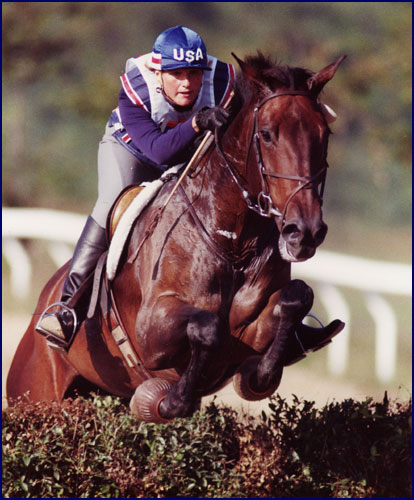
Albany and I on the Steeplechase.
|
Phase C, the second
Roads and Tracks, seemed endless, but eventually we made it to the Vet
Box. Chef d’equipe Michael
Paige, team veterinarian Marty Simensen, Bruce and most of the other
riders; they were all there to tell me how the course was riding and offer
assistance. The lengthy course
and demanding terrain was taking its toll; when I was in the Vet Box nine
horses had started the course ahead of us, but none had yet finished it.
This trend continued throughout the day; there were few clear
rounds, and lots of falls and eliminations.
My instructions from Michael Paige were to
try for a steady clear round, and not take chances with the time.
The only specific instructions that he gave me that differed from
my own plan was to take the long route at the combination at number 17
rather than the direct corner option; only one rider had tried the corner
so far, and had a run-out.
We were about ready to walk into the Start
Box – and there was a ‘hold’ on course.
This is never good for the nerves, but I reminded myself that we
had been held at the start at the selection trials at Kentucky, and that
had worked out OK. (I later
learned that as I went to the Start Box I was being televised live on
prime time TV - when the hold occurred they cut to commercial, and then
picked me back up when I was about half way around the course.)
Before long, the hold was over and I rode
toward the Start Box. Even
though I felt nervous, it was a positive tension. After
years of competing, I had learned how to turn my nerves into a competitive
edge. There was a moment, just
before the start of the cross-country, of wonderful anticipation.
“This is it. It is
what we have trained for all these years.
We have earned our way here, and all the preparation has been done.
We have negotiated the Roads and Tracks, galloped the Steeplechase,
and gotten through the Vet Box with no major mishaps.
Everything I have worked for, everything I hope and dream, comes
down to this, what Albany and I do in the next thirteen minutes.
It is all laid out there before us.”
As I walk into the Start Box, I think that
this has to be the most important day of my life.
It is time for the countdown – I punch my stopwatch – 3-2-1-GO!
We are off and running.
We are on course and galloping down to the
first fence, a straightforward slanted palisade.
The second is a large hedge; I can feel the toe of my boot against
the brush, actually forcing my boot outward.
Albany has found his rhythm quickly, and is galloping and jumping
well. Next is a ski-ramp type
road barrier, big but inviting, then around a turn and straight down a
steep hill to the Bamboo Drop, a very upright vertical, the first big
question on the course. Albs
stays balanced and nips over it tidily.
The galloping lanes are narrow and twisty,
lined the whole way with the blossoming cosmos.
I can hear spectators calling out “Go, Phyllis” and Go USA!”
This is a huge boost. Next
is a wide cordwood pile oxer on the side of a hill, built in sections like
a Helsinki, then five strides to a maximum table.
Albany makes it feel easy. Number
7 is a triple bar made from drainage pipes, probably the easiest fence on
the course.
On to the first water complex, numbers 8,
9 and 10AB. There are at least
four different routes through this, but all involve a 3’11 airy vertical
into the water. We take the
direct route, jumping the first upright rails, then four short strides
down the slope to the vertical into the water.
The water was over a foot deep, and we were crossing it for a dozen
strides. Then up a bank, and I
kick for the two long strides up a knoll and out over an airy gate.
There are several short twisty turns, then
a long gallop to the next fence, a 4’6 bullfinch made of cornstalks,
then two strides on an angle to a maximum width (5’11) table.
Albany jumps way up in the air over the cornstalks rather than
brushing through, but makes easy work of the table.
As we gallop I can hear people cheering
for me, and cheering for the US; this gives me a real high.
The next combination is the Mt. Sorak Steps; two 3’9 steps at a
bounce distance up the hill, then a one-stride to another bank, and then a
bounce over a big brush. The
slope up is steep, and this sequence requires a huge effort from the
horses.
|
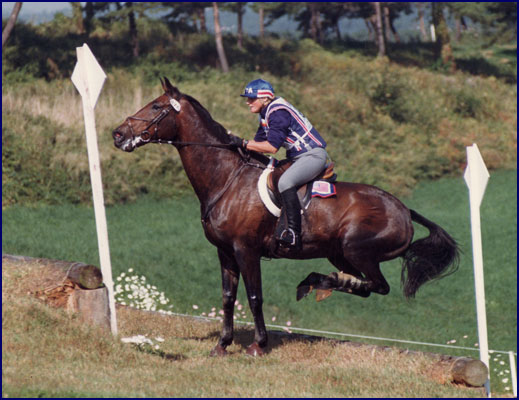
Jumping the Mt. Sorak Steps.
|
We wind through the woods to the Namsan
Mountain, named after the mountain that looms over Seoul.
The obstacle is as impressive as the mountain; a big vertical
palisade at the top of a steep hill, with a blind drop into space, landing
on a steep downward slope. I
give Albany a tap with my stick as we come up the hill and he leaves long,
putting in a tremendous jumping effort.
It seems like we are in the air forever, before becoming earthbound
halfway down the hill.
Fence 15 is Hodori’s Ditch; the direct
route is a short approach to a very wide ditch and rails.
We fly it, and gallop on to the encouraging cheers of spectators.
We gallop up yet another steep hill – you really need a fit horse
for this course – to the Birch Gardens.
This is a straightforward oxer, but very wide, with a steep
downhill on the landing side. I
give Albs a tap with the crop to make sure he is sharp, and come at it
fast and strong to make the width easier.
As we land I collect him to go down the steep slope to Chosun’s
Choice, a corner option at the bottom of the hill.
This is where I had planned to do the corner, but riding to team
orders I play it safe and take the long option.
Up another hill, over a knoll, and down
yet another slope, to a very large hedge oxer.
We head for the wider left side of the fence for the fast route,
and leave on a longer stride than I like.
Sorry, Albany, didn’t mean to make your job harder.
I can feel the terrain taking its toll, but I still have plenty of
horse left. I can hear
spectator’s cries of “Go USA!” Number
20 is the Tank Trap, a zig-zag rails over a ditch, then on to a big airy
oxer at 21.
We gallop downhill to the second
water complex: a large stone wall, three strides to a vertical with an
imposing six foot drop into the water, then several strides through the
water and up a bank onto an island, with a bounce over rails dropping back
into the water, followed by a final small step up onto land.
The bounce bank island would cause plenty of problems throughout
the day, but Albany skips through it.
|
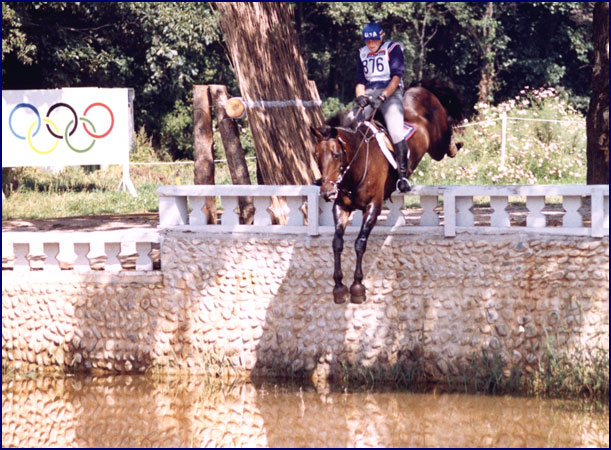
Albany and I jump the second Water complex in Seoul.
|
We are three-quarters of
the way around the course, and though I can feel Albany getting tired, he
is still trying hard. We jump
the narrow zigzag gates on a sharp angle of approach, collecting up to a
show jump canter for this airy upright.
Next is a huge spool-type fence of oversized flowerpots, and a turn
to the Wondang Walls, a maze of vertical walls downhill through the trees.
(Originally the final element had been a bounce, but the ground
jury decided to remove the final element because it was considered too
demanding for tired horses at the end of the course.)
Albany is easy to collect, and nips through tidily.
We sail over the direct route at #29,
called No Gan Joo, a brush with a seven foot ditch on the takeoff side.
Then on to the last major question on course, the taxi stands.
We go up a steep incline, jump a one-stride pair of verticals set
under taxi stand roofs, the second one with a sizable drop on landing.
I can’t believe we are almost home!
Then a long gallop to the last, a big table, and we lengthen uphill
to the finish flags. We’re
through!
I ask permission to dismount and weigh in
– and then everyone is there – Michael, Bruce, Jineen, my mother –
we are all hugging and kissing and I’m crying and everyone is telling
Albany how wonderful he is. Jineen
takes Albany back to the stables as I am telling my teammates how the
course rode. The TV cameras
are all around and I am being interviewed about my ride.
Albany and I had the
ride of our lives, and we didn’t have a single bad fence.
When I galloped through those finish flags, having jumped clear,
the feeling was incredible - definitely one of the highlights of my life.
We had time penalties, but Albs couldn’t have jumped better.
My score was good enough to retain my 10th place
standing after cross-country.
Unfortunately the rest of my team didn’t
fare so well. Karen and Ann
were both eliminated for multiple falls (the third fall of horse was
elimination in those days!) Ann
and Tarzan had two falls at the sixteenth when Tarzan tried to bounce the
wide oxer, and had to retire. Karen
fell at the downhill vertical at Fence 4, and then fell twice at #16 when
the Optimist also tried to bounce the oxer.
Bruce had a fall at the zig-zag at Fence 20 after Dr. Peaches
pulled a shoe and slipped, but finished the course.
I was watching on the closed circuit TV in the vet box, and it was
devastating to watch my teammates come to grief.
On a better note, it was really exciting
to watch Mark Todd of New Zealand finish the course on Charisma, with a
clear round twenty seconds inside the time.
As many riders as could fit were in the tent watching on the vet
box TV monitor, and the cheering and clapping was a testament to the
popularity of this talented pair. Olympic
Individual Gold Medal winners in Los Angeles in 1984, Mark Todd and his
partner Charisma, now age 16, went on to win the individual Gold Medal
again in Seoul. It was a fairy
tale performance that we were lucky to get the chance to witness.
Our failure to compete
as a team made for a somber mood around the barn, but I was personally
happy with the performance Albany and I had put in.
Albany was a bit stiff and sore after the demanding endurance test,
and Jineen iced him half the night. To
our relief he jogged up sound the next morning, and the horses were vanned
back to the main Equestrian venue for the Show Jumping.
Albany jumped well, having just one fence
down. We finished the
competition in 10th place, which had been our ranking after
each phase, as well as our starting position.
I felt a real sense of pride to have competed against the best in
the world and come out so well. Still,
it was bittersweet because of our team’s failure to even finish.
|
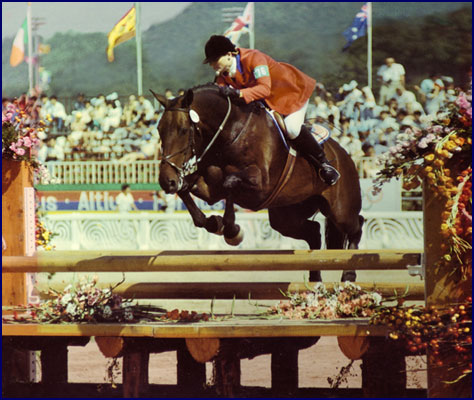
Albany and I show jumped well to clinch our
10th place finish.
|
Back in the stable after the jumping, Shamus Brady, an Irishman who was
our team farrier, suddenly noticed for the first time the framed
four-leaf-clovers on Albany’s stall, and commented “No wonder you did
so well!”
We were stabled just down from the New
Zealand team. After Mark Todd
won the individual Gold Medal with Charisma, they threw a massive party in
their stable area. There was
plenty of champagne all around, and I seem to remember a number of people
being thrown into the watering trough.
|
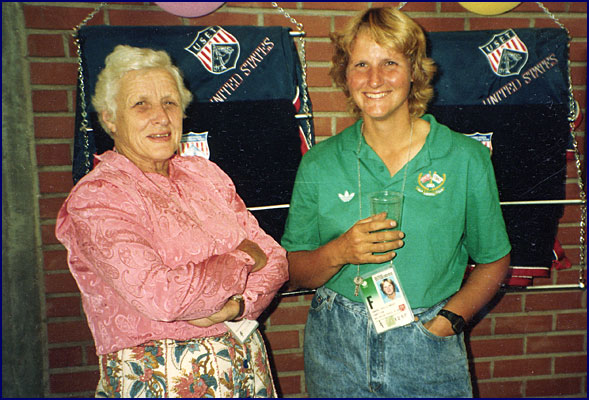
Mom and I celebrating at the party after it was
all over.
|
Nick Holmes-Smith and
David Wilding-Davies from Canada were hand-walking Nick’s reserve horse;
when they came by the party they were somehow coerced (alcohol may have
been involved) into both getting on the mare double, bareback, in a halter
and leadrope. The suggestion
was made that they should jump, and immediately several people ran into
the US aisleway for supplies, and quickly constructed a jump out of hay
bales, a wooden bench, and a large potted plant.
David turned the mare around for a running start, with Nick
clinging on behind, and cantered down to the obstacle.
The mare sailed over the bench, and then proceeded to buck them
both off into the dirt.
|
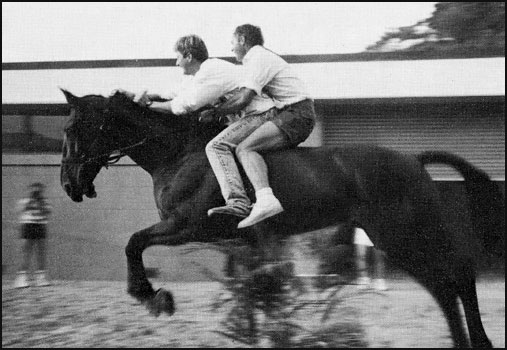
David Wilding Davies and Nick Holmes-Smith at the New
Zealand Victory Party.
|
After having been away
at the cross-country venue for two nights, when I arrived back to my room
at the Olympic Village that evening I was surprised to find flowers
waiting for me, and dozens of telegrams from people back home.
Many were from people I didn't even know, people who had seen me
ride on TV and were sending me messages of congratulations.
The Olympic competitions were all broadcast live, and with the time
difference, my cross-country round ended up being shown on NBC during
prime-time. As the highest
placed American, and indeed the only member of our team to jump clear on
cross-country, I received a lot of positive press.
The next morning a photo of Albany and me on the Steeplechase phase
made the front page of the Sports Section of USA Today.
(My brother later cut out that picture and pasted it on a box of
Wheaties as a gift for me!)
By the time the Eventing competition was
over, we had been in Seoul for nearly a month.
As fantastic an experience as it had been, I was eager to get home.
Along with the other members of my team, I flew home a few days
after I was done competing. At
the time it seemed like the right thing to do, but later I wished I had
stayed until the end of the games, watched more of the other sports, and
attended the Closing Ceremonies.
It was only after I went to the Olympics
that my older brothers started to take what I did for a living seriously.
Until then, they had always had a bit of an attitude of “When are
you going to grow up and stop riding horses and get a real job?”
But after the Olympics, they were impressed, and took a different
outlook. “Wow, tenth
place,” one of them said. “Tenth
in the world. How would you
like to be tenth in the world at what you do?”
Well, I was never under any illusions that I was really the tenth
best rider in the world. But
on that one day, for a moment in time, I was.
|
Hand
In Hand -
by Koreana
(Theme song of the Seoul Olympics)
See the fire in the sky
We feel the beating of our hearts together
This is our time to rise above
We know the chance is here to live forever
For all time
Hand in
Hand we stand
All across the land
We can make this world
A better place in which to live
Hand in
Hand we can
Start to understand
Breaking down the walls that come
Between us for all time
Hand in Hand
Every time
we give it all
We feel the flame eternally inside us
Lift our hands up to the sky
The morning calm helps us to live in harmony
For all time
Hand in
Hand we stand
All across the land
We can make this world
A better place in which to live
Hand in Hand we can
Start to understand
Breaking down the walls that come
Between us for all time
Hand in Hand
|
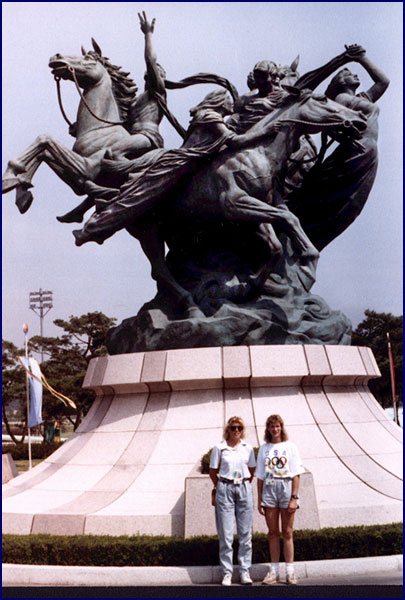
|
|



















